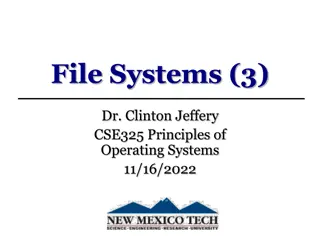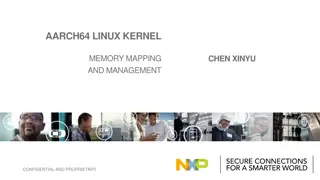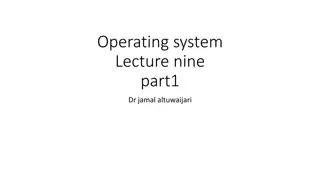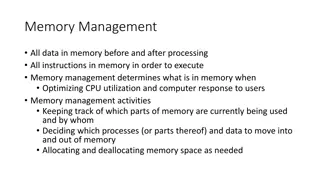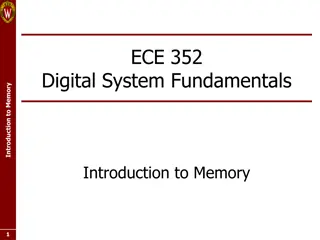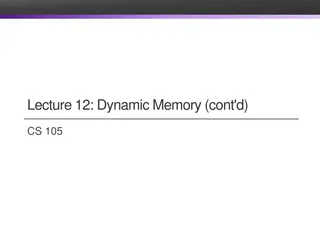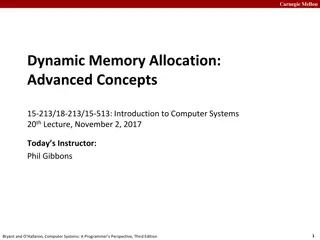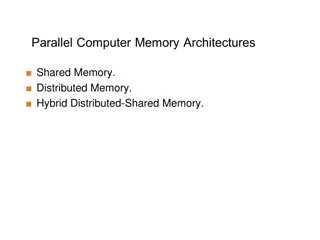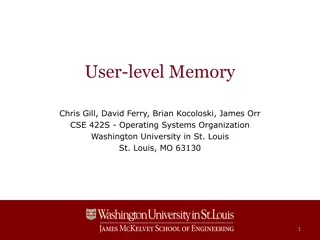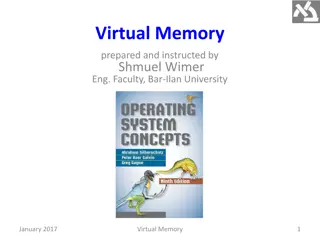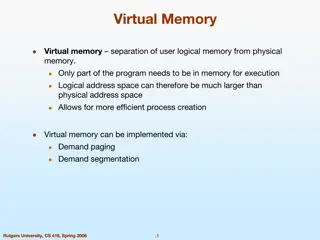Memory Allocation in Operating Systems
Memory allocation in operating systems involves fair distribution of physical memory among running processes. The memory management subsystem ensures each process gets its fair share. Shared virtual memory and the efficient use of resources like dynamic libraries contribute to better memory utilization. Mechanisms like shared memory IPC facilitate information exchange between processes. The abstract model of virtual memory to physical memory mapping in Linux enhances system performance.
Download Presentation

Please find below an Image/Link to download the presentation.
The content on the website is provided AS IS for your information and personal use only. It may not be sold, licensed, or shared on other websites without obtaining consent from the author.If you encounter any issues during the download, it is possible that the publisher has removed the file from their server.
You are allowed to download the files provided on this website for personal or commercial use, subject to the condition that they are used lawfully. All files are the property of their respective owners.
The content on the website is provided AS IS for your information and personal use only. It may not be sold, licensed, or shared on other websites without obtaining consent from the author.
E N D
Presentation Transcript
The memory management subsystem allows each running process in the system a fair share of the physical memory of the system.
bash command shell. Rather than have several copies of bash, one in each process's virtual address space, it is better to have only one copy in physical memory and all of the processes running bash share it. Dynamic libraries are another common example of executing code shared between several processes.
mechanism, with two or more processes exchanging information via memory common to all of them. Linux supports the Unix System V shared memory IPC. 3.1 An Abstract Model of Virtual Memory
Figure 3.1: Abstract model of Virtual to Physical address mapping
Linux uses to support virtual memory it is useful to consider an abstract model that is not cluttered by too much detail.
contents of a location in memory. The processor then executes the instruction and moves onto the next instruction in the program. In this way the processor is always accessing memory either to fetch instructions or to fetch and store data.
physical addresses. These virtual addresses are converted into physical addresses by the processor based on information held in a set of tables maintained by the operating system.
need not be but if they were not, the system would be very hard to administer. Linux on Alpha AXP systems uses 8 Kbyte pages and on Intel x86 systems it uses 4 Kbyte pages. Each of these pages is given a unique number; the page frame number (PFN).
frame number. Each time the processor encounters a virtual address it must extract the offset and the virtual page frame number. The processor must translate the virtual page frame number into a physical one and then access the location at the correct offset into that physical page. To do this the processor uses page tables.
instructions executed by a processor. Such events correspond to electrical signals generated by hardware circuits both inside and outside of the CPU chip.
Interrupts are often divided into synchronous and asynchronous interrupts:
Synchronous interrupts are produced by the CPU control unit while executing
instructions and are called synchronous because the control unit issues them only after terminating the execution of an instruction.
CPU clock signals. Intel 80x86 microprocessor manuals designate synchronous and asynchronous interrupts as exceptions and interrupts, respectively. We'll adopt this classification, although we'll
from a user sets off an interrupt. Exceptions, on the other hand, are caused either by programming errors or by anomalous conditions that must be handled by the kernel. In the first case, the kernel handles the exception by delivering to the current process one of the signals familiar to every Unix programmer. In the second case, the kernel performs all the
steps needed to recover from the anomalous condition, such as a page fault or a request (via an int instruction) for a kernel service.
by placing an address related to the interrupt type into the program counter. There is a key difference between interrupt handling and process switching: the code executed by an interrupt or by an exception handler is not a process. Rather, it is a kernel control path that runs on behalf of the same process that was running when the interrupt occurred. As a kernel control path, the interrupt handler is lighter than a process (it has less
Interrupt handling is one of the most sensitive tasks performed by the kernel, since it must satisfy the following constraints:
back to whatever was running before, and do the rest of the processing later (like moving the data into a buffer where its recipient process can find it and restarting the process). The activities that the kernel needs to perform in response to an interrupt are thus divided into two parts: a top half that the kernel executes right away and a bottom half that is left for later. The kernel keeps a queue pointing to all the functions that represent bottom halves
handlers must be coded so that the corresponding kernel control paths can be executed in a nested manner. When the last kernel control path terminates, the kernel must be able to resume execution of the interrupted process or switch to another process if the interrupt signal has caused a rescheduling activity.
interrupts must be disabled. Such critical regions must be limited as much as possible since, according to the previous requirement, the kernel, and in particular the interrupt handlers, should run most of the time with the interrupts enabled.
The Intel documentation classifies interrupts and exceptions as follows:
microprocessor. They can be disabled by clearing the IF flag of the eflags register. All IRQs issued by I/O devices give rise to maskable




